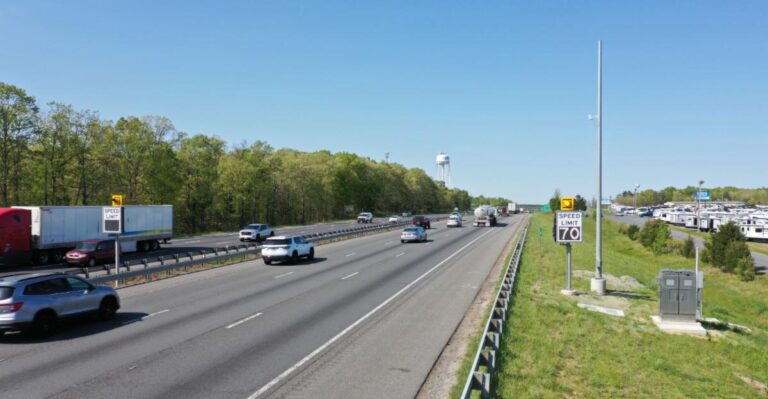FREDERICKSBURG, Va. — New LED signs with the capability to display variable speed limits have been illuminated along Interstate 95 northbound in Caroline and Spotsylvania counties and in the City of Fredericksburg.
According to a news release from the Virginia Department of Transportation (VDOT), variable speed limit signs, paired with changeable message signs, will replace static speed limit signs over a 15-mile section of I-95 northbound. The new signs are located between exit 110 (Ladysmith) and exit 130 (Route 3/Fredericksburg), from mile markers 115 to 130. The variable speed limit signs are located every half-mile to one mile in the project corridor, with a total of 48 speed limit signs, installed in pairs.
For several days after illumination, the variable speed limit signs will display only the maximum speed limit of 65-70 mph to help motorists adjust to their presence.
Starting on Wednesday, June 22, the system will be fully activated to display variable speed limits between 35 mph and 70 mph.
Drivers will be expected to adjust their speed in this area based on information about real-time traffic conditions and delays on the road ahead. Gradually slowing traffic as it approaches congestion will help to reduce the risk of crashes and stop-and-go backups.
“When we studied the I-95 corridor to identify areas for operational improvements, we found recurring congestion was contributing to crashes and driver delay at this location, especially on weekends and during holidays,” said Mena Lockwood, P.E., assistant state traffic engineer for the Virginia Department of Transportation (VDOT).
“Northbound motorists approaching this area are often surprised by a sudden slowdown in traffic, and brake sharply,” Lockwood said. “By installing this variable speed limit system here, we can lower vehicle speeds before travelers reach the point of congestion. This reduces the risk of crashes and resulting injuries, and it maximizes our ability to keep traffic moving.”
Flashing beacons attached to the signs will be activated when speed limits are reduced below the maximum limit. Additional static signs posted on I-95 northbound before mile marker 115 will notify drivers they are entering a variable speed limit corridor.
Message boards controlled by operators in VDOT’s Traffic Operations Centers will communicate the reason why speed limits are being lowered, such as congestion ahead, weather conditions, or lane closures for crashes, work zones or other incidents. Six new 511Virginia traffic cameras will be installed in the corridor by summer 2022 as part of this project, which will assist with traffic monitoring.
Speed limits will be reduced by only 10 mph at a time, and will hold at that speed for at least a minute so drivers can reduce speed at a comfortable rate.
When congestion clears, the speed limits will go up directly to the maximum allowable speed limit.
Variable speed limits posted on the LED signs are enforceable, just as with any other posted speed limit sign.
How the System Works
Vehicle detectors installed along I-95 use radar to collect traffic speed and volume data, which is fed into a software program. The program uses an algorithm to recognize when speed limits should be lowered, such as when traffic volumes are heavy and speeds are high. The program then assigns incrementally lower speeds to harmonize traffic flow and reduce the risk of crashes and congestion.
Vehicle detectors do not identify individual vehicles or gather license plate information.
Detection equipment has been operational in the I-95 northbound project corridor since fall 2021. This has allowed the project team to perform advanced system testing and study how seasonal travel patterns and inclement weather affects vehicle speed and congestion.
Backup power will operate the variable speed limit signs and system for up to 24 hours in the event of power loss, and dual signs have been installed at each location to provide redundancy. If a system component experiences a failure, VDOT’s on-call maintenance contractor is required to schedule a repair within 8 hours.
The Trucker News Staff produces engaging content for not only TheTrucker.com, but also The Trucker Newspaper, which has been serving the trucking industry for more than 30 years. With a focus on drivers, the Trucker News Staff aims to provide relevant, objective content pertaining to the trucking segment of the transportation industry. The Trucker News Staff is based in Little Rock, Arkansas.














